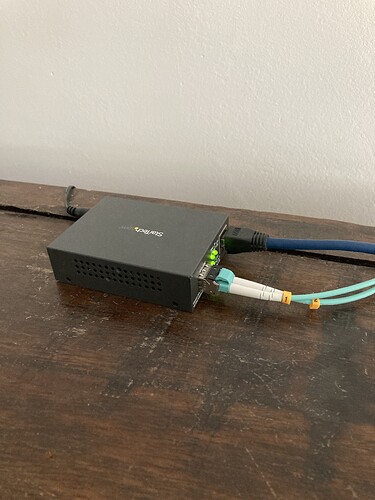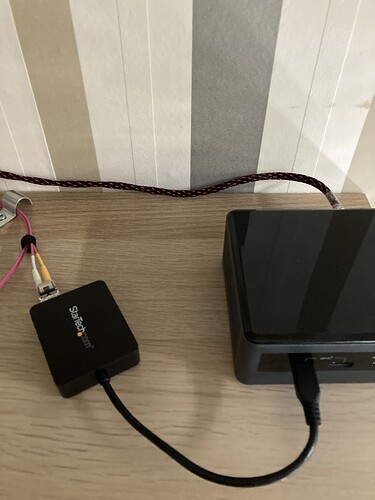If you have a problem with copper that can be solved with fiber, then you have a ground loop. As simple as it is. No magic.
numbers matter, and it wasn’t 12MB
Or you need longer range, or you need more than 10G…
granted neither of these are usually required for home audio (-:
I try my best to avoid such discussions especially in an objectivist forum.
For those who are interested, read the EtherREGEN white paper for a hypothesis on clock, and determine whether you choose to believe it or dismiss it. Disclaimer: NOT an endorsement.
I’ve read it and I don’t believe it. The EtherREGEN has been tested and found to make no audible difference using an Audio Precision Analyser:
From John Swenson -
“There are two types of sound-degrading influences the EtherREGEN is designed to radically decrease: Leakage—both high-impedance and low-impedance—and clock phase-noise. The clock phase-noise travels on the Ethernet signal itself and on power- and ground-planes. [Every signal edge coming out of any digital device carries the jitter/phase-noise of the clock used to “clock out” that edge; this shows up on the ground-plane and affects the threshold of chips’ clock inputs. This is an oversimplification of a complex subject; here is the link to our ‘white paper’ about the technical mechanisms (to be followed with some measurement proof of the effects).”
To my knowledge, he is yet to come up with some measurement proof of the effects…
etherRegen has been tested and the tester could not find any difference in measurements. That’s not the same as saying there are no audible differences (despite what Amir with his disciples thinks). Its not possible to test for audible differences using measurements, you need ears for that.
etherRegen has also been tested using ears and found to give better sound (including by me, I borrowed if for a few weeks). In fact, it was very easy to spot differences, since the soundstage became wider and some instruments moved a couple of dm more away from speakers (good luck measuring that  )
)
I really should do the same, I always get dragged into these meaningless discussions with “bits are bits” people ![]()
So, you’re saying that a $28,000 audio analyser which can detect signal changes orders of magnitude below the threshold of human hearing and which shows there is no difference in an audio signal with or without the EtherREGEN doesn’t conclusively prove that the EtherREGEN doesn’t work?
I have no objection to testing with ears, but those tests have to be done blind to preclude any cognitive or expectation biases. Audiophiles repeatedly deny that blind listening tests are necessary, yet common scientific sense says they are essential.
Perhaps you should. No one is dragging you into the discussion. You choose to partake. The discussions aren’t meaningless, however. You can’t scientifically defend an indefensible position based on hand-waving pseudo-science.
The discussion was originally about SFP/SFP+ fibre instead of 10/100/1000 copper and it’s way off topic. There’s no benefit to fibre over copper unless the levels of interference in the environment are so severe that bit loss becomes an issue (this in practice is rare as you would move to fully screened and shielded infrastructure), or unless you need to exceed the useful range of copper (~300m), or unless you need to exceed the useful bandwidth of copper (10Gbit/s).
I’m pretty sure none of the above apply to home audio.
People believe in a lot of things that are not proven, and are often things theoretically impossible.
Your proof, even when it is a law of nature, is not proof enough, and will never be.
A belief is to strong for the best of proof… forget it.
Nice bit of entertainment though, seeing audiophile silly believers defending their beliefs.
There is no proof that everything heard can be measured, and its even been shown that you need a dynamic range of about 300dB to fully hear 3D effects. Good luck measuring that on your fancy $28000 measurement 
So you guys believe in measurements, I believe in listening. No one can prove anything.
I can however give an example: if I use a normal ethernet cable and listen 1:10 into Dreamer by Sophie Zelmani, the whispering is about 5 dm to the right of the right speaker, if I use my homemade adapter its over 1m to the right of the right speaker (in my setup and room). Obviously this is easily 10 out of 10 in a blind test.
I doubt that can be measured, and I know Amir can’t despite his fancy equipment. Or maybe it can be measured but the interpretation is to crude or faulty. Either way, it shows that ethernet cables matter (and yes, its easy to hear difference between ethernet and fiber, at least in my setup).
Btw, here is my setup on the digital side, nothing very expensive but very transparent:
TrendNet switch with SFP port → fiber → opticalModule → ethernet adapter → upgraded microRendu → RME ADI-2 DAC (everything runs on 20Ah LiFePo4 cells).
Running ethernet cable straight from switch to microRendu gives a quite large difference in sound. Fiber leads to more details and clarity, but a little lean and thinner sound. Which you like is personal preference.
etherRegen does sound a little better than my solution though, which is annoying but to little to be worth the cost of the etherRegen
If you haven’t blind tested it…
Setting up a blind test is not easy, but it’s not beyond the realms of possibility.
People want to hear a difference, so they hear a difference…
I’m sorry, but that’s just nonsense. The limitation of human hearing is at the very, very best 0dB SPL at 1 kHz (worsens with age) -9dB SPL in the range of 2kHz - 5 kHz to about 120dB (threshold of pain), so you don’t need a 300dB dynamic range. Prolonged listening above 85dB causes long-term hearing damage, so in real terms, if you don’t want to lose your hearing an 85dB - 94dB range is all we humans have to work with.
I’d love to see where the 300dB figure came from!
First of all, dynamic range of 300 does not mean you have to listen to 300dB (which would kill you), read up on it if you need. Its more like SNR.
Anyway, Rob Watts, chief engineer at Chord Electronics, wrote a paper about it and his finding was 300dB to fully hear 3D/depth sound, complain to him if you think you know better ![]()

